Ata-ul-Haye Nasir and Iftekhar Ahmed, UK
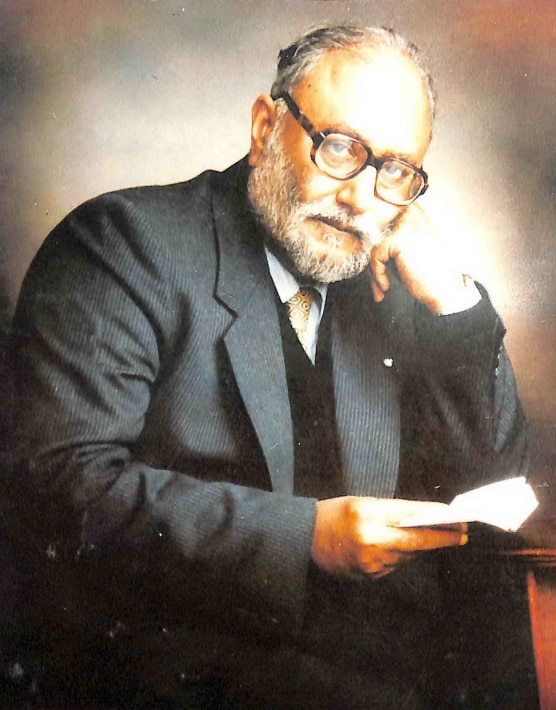
Time and again, those whose eyes are green with envy at the success Ahmadi Muslims have achieved around the world lash out, attacking the individual achievements of Ahmadis and seeking to discredit them.
While eminent figures like Prof. Brian Cox, a professor of particle physics at the University of Manchester, laud the contributions of Prof. Dr Mohammad Abdus Salam to the field of physics in the highest terms, a voice of wilful defamation of the Ahmadi Muslim Nobel laureate emerges. A pseudo-intellectual, utterly unequal to the subject, has attempted to assert that Dr Salam did not actually deserve the Nobel Prize. A closer look reveals him to be someone cosying up to Pakistan’s religious far-right. In his X biography, devoid of substantive credentials, he presents himself merely as a “critic”—a designation that seems to be his sole qualification and description. He is not an individual engaged in positive, creative work that propels society forward. Rather, his sole aim appears to be undermining the achievements of others, maintaining his relevance by promoting conspiracy theories about the real, substantive work of more productive minds.
He claims his motives are not rooted in hatred for Ahmadi Muslims, but such assertions prove to be mere babble when one examines his track record of railing against Ahmadis for quite some time, with his recent YouTube video simply the most recent instalment in this sorry series. This YouTuber, who bemoans “unoriginal” work, has ironically adopted the groundbreaking strategy of constructing his entire video around the recycled arguments of a certain Professor Norman Dombey.
45 years have elapsed since Dr Salam was awarded the Nobel Prize, and during that time, many critics have emerged, only to have their objections refuted by those far more qualified to weigh in on the matter—a trait this particular individual sadly lacks.
A cursory glance at Wikipedia’s comprehensive listing of so-called “Nobel Prize controversies” reveals a conspicuous absence: the year 1979, when Prof. Abdus Salam was honoured for his groundbreaking work in theoretical physics. The list chronicles debates surrounding the awards in 1923, 1938, 1974, 1978, 1983, 1997, 2005, 2008, 2010, 2013, 2014, and 2017—but no such controversy is noted for 1979. One must wonder, then, what ulterior motives or vested interests could be driving this attempt to stir up controversy over something long considered uncontroversial in the scientific community.
Engaging in the scientific details would be futile, as the critic himself does not delve into such technical depths. His charges against Dr Salam rely not on scientific dissection, but on selective quotations and perspectives. We shall not rebut the scientific merits, as Dr Salam’s work needs no vindication from us. Instead, we will expose the inadequacies of the arguments presented in this video and the motives behind them.
In support of his claim that Prof. Salam was undeserving of the Nobel, the critic leans heavily on the words of Norman Dombey, a professor of physics and astronomy at the University of Sussex. He also presents comments from Sheldon Lee Glashow, who shared the 1979 Physics Nobel with Salam and Steven Weinberg.
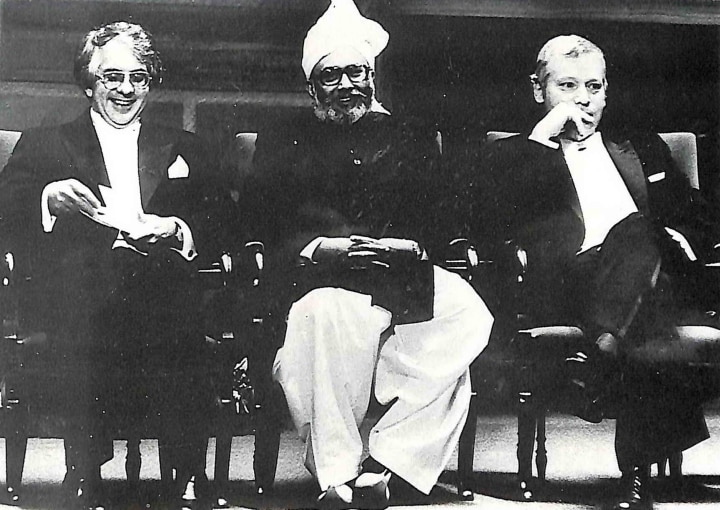
In an interview with David Zierler on 3 June 2020, Glashow referenced Dombey’s paper, stating, “Everything he says is true, to my knowledge.” (www.aip.org) However, it is important to note the measured critique of Peter Woit, a senior lecturer in the mathematics department at Columbia University. Interestingly, Glashow was Woit’s undergraduate advisor at Harvard, where Woit studied from 1975-79. Commenting on Dombey’s paper, Woit stated that Dombey “more or less seems to argue that Salam didn’t deserve his 1979 Nobel. He describes a lot of history I didn’t know, but I’m not completely convinced.” (Not Even Wrong: “How to Win the Nobel Prize”, www.math.columbia.edu) This nuanced perspective from a respected voice in the field highlights the lack of convincing evidence in Dombey’s argument against Prof. Salam’s deserving of the 1979 Nobel Prize.
Plagiarism?
In a bold accusation of plagiarism, the video presents an excerpt from Sheldon Lee Glashow himself, Dr Salam’s co-recipient of the 1979 Nobel Prize in Physics. In his interview, Glashow states:
“My Nobel Prize depended on that one paper written in 1960. Steve’s Nobel Prize depended exclusively on that one paper he wrote in 1967, a wonderful paper which applied the notion of spontaneous symmetry breaking to the—my electroweak model. So, the question arises, what did Salam do? He introduced the electroweak—the SU(2)XU(1) model in 1964. That was over three years after I did. He copied my work but did not cite me.”
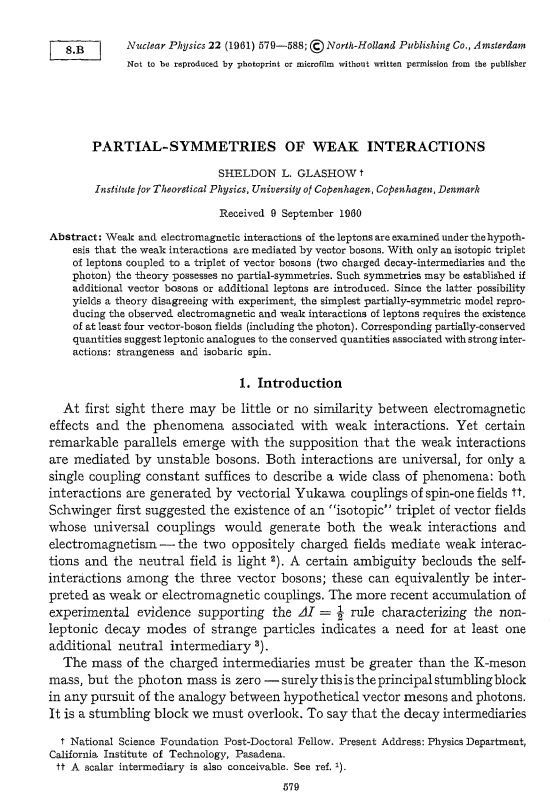
Yet this allegation stands in stark contrast to Glashow’s own words in his Nobel Lecture of 8 December 1979, in which he speaks quite clearly about the communal nature of scientific discoveries:
“All is woven together in the tapestry; one part makes little sense without the other. Even the development of the electroweak theory was not as simple and straightforward as it might have been. It did not arise full blown in the mind of one physicist, nor even of three. It, too, is the result of the collective endeavor of many scientists, both experimenters and theorists.” (“Towards a Unified Theory—Threads in a Tapestry”, www.nobelprize.org)
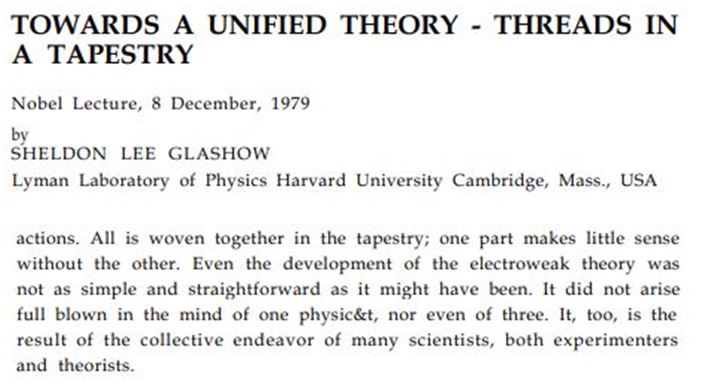
The video acknowledges the possibility of independent minds arriving at similar conclusions, but quickly dismisses this notion by presenting Glashow’s response to a direct inquiry on the matter:
“Absolutely not. He knew my work when I wrote a paper—falsely claiming that the Yang-Mills theory would be renormalizable when masses were put in by hand. I claimed it would be renormalizable. I spoke about that work in London when I visited in 1959. Salam listened patiently to my work. And when I got back home, there were two articles awaiting me from his institution, one by him, another by a Japanese co-worker, each of them showing that I had made a stupid mistake and that my paper was wrong. So, he certainly read my papers carefully. I have no doubt that he had read my 1961 paper as well, because the similarities were too great in his 1964 paper. In any event, even if independently conceived, it was fully three years later.” (“Oral History Interviews | Sheldon Glashow”, www.aip.org)
However, in his haste to indict Dr Salam, the critic stumbles into a quagmire of chronological confusion. He erroneously conflates Glashow’s 1959 Paper—which Glashow also presented at Imperial College London at Dr Salam’s invitation—with Glashow’s 1961 Paper. This misunderstanding leads him down a rabbit hole of spurious claims. He does not seem to comprehend that it was Glashow who had to admit to making ‘stupid mistakes’ in his 1959 Paper—mistakes that were rightfully critiqued by Dr Salam and a Japanese colleague. The critic then ludicrously contends that Glashow’s 1961 Paper ultimately proved sound, rendering the criticisms from Prof. Salam invalid. Yet, this entire narrative is built on a foundation of sand, a muddling of the 1959 and 1961 papers, for it was indeed Glashow’s 1959 work that drew warranted criticism—a fact Glashow himself conceded—not his subsequent 1961 publication.
If one is not intimately familiar with the history of these events and has not studied them in depth, such a mistake can easily creep in when relying solely on this isolated statement from Glashow.
What actually happened is chronicled in the very work the critic himself later cited. He seems, however, not to have studied that work thoroughly, cherry-picking only what fits his pernicious agenda. We read:
“Nonetheless, by November 1958 Glashow had convinced himself—erroneously, as it would turn out—that his theory was in fact renormalizable. He wrote a paper that was published in the journal Nuclear Physics on New Year’s Day, 1959. [“The Renormalizability of Vector Meson Interactions,” Nuclear Physics, Vol. 10, pp. 107-117]
“During 1958 Salam too had been attempting to unite the weak and electromagnetic interaction. He had responded to Ward’s suggestion that they build a theory of the weak interaction by inviting Ward to join him at Imperial College. They had read Schwinger’s paper that suggested the existence of a massive W boson and were trying to unite the weak and electromagnetic forces themselves. They completed their paper at almost the same time as Glashow, and it was published in February 1959. [“Weak and Electromagnetic Interactions” (Il Nuovo Cimento, Vol. XI, No. 4, 16 February 1959, pp. 568-577)]
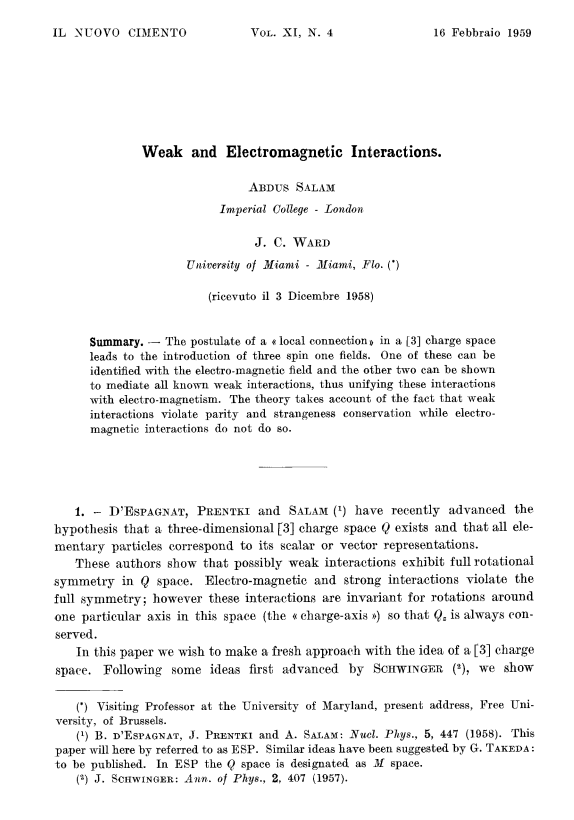
“Glashow’s paper examined a model containing a triplet of ‘photons,’ or gauge bosons, the conventional photon being partnered by two electrically charged massive siblings. This was similar to what Salam and Ward were also doing at that juncture.
“The peripatetic Ward had left Imperial College on his travels when Glashow came to give a talk in the spring of 1959. Glashow was claiming that his theory was renormalizable. The problem was that Salam and Ward, both experts on renormalization, had been unable to get rid of infinities, which kept emerging from their calculations like mushrooms. Consequently, Salam was astonished when ‘this young boy’ claimed that the theory was viable—renormalizable—after all.
“During the days immediately after Glashow’s visit, Salam was sufficiently worried that he and colleagues went through the arguments carefully. What could Salam and Ward have missed? In fact, they had overlooked nothing. Glashow’s claim that the theory was renormalizable was completely wrong, and if Glashow had done the calculations properly, he would have shown that the infinities were unavoidable, the exact opposite of what he had thought.
“Glashow was extremely embarrassed. Years later he recalled the episode as follows: ‘Anyone competent in quantum field theory could have spotted my error. Nonetheless, Abdus Salam invited me to speak about my work at Imperial College. My talk was well received and afterward, Salam had me to his home for a marvelous Pakistani dinner. But when I returned to Copenhagen, two Imperial College preprints awaited me showing that I was wrong. Couldn’t Salam simply have told me of my mistake?’
“Whatever the truth of this in detail, Salam’s reaction was mixed. On the one hand, he must have been relieved that he and Ward had not overlooked something so basic. They were, after all, two of the world’s leading experts on renormalization, and it would have crushed their morale to have missed making such a discovery themselves, leaving a graduate student to uncover the great truth. This was their first contact with Glashow, and it left Salam somewhat scornful. Salam was a bit inclined to put people in categories and not move them out again. This episode was an extreme example, Salam claiming that as a result he never again read any of Glashow’s papers, although he himself later admitted that this was a mistake.” (The Infinity Puzzle, Frank Close, 2011, Basic Books, New York, pp. 114-115)
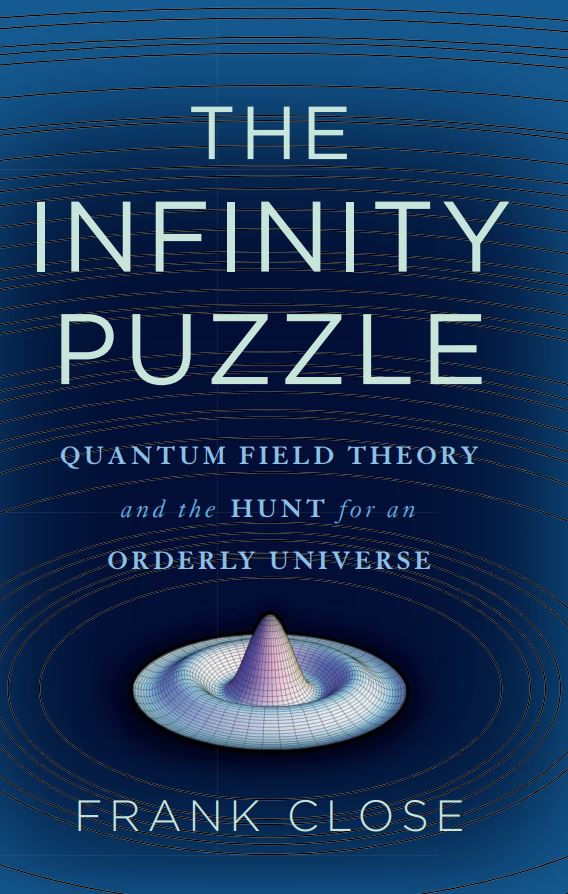
The following facts emerge from this quote: Firstly, that it was not Glashow’s 1961 paper that Prof. Salam had criticised. Secondly, that his criticism was justified and that even Glashow knew this and had to recognise it. Thirdly, and this is a crucial fact, that Prof. Salam had not studied any of Glashow’s papers after this gross blunder. Therefore, Prof. Salam could not have known anything about Glashow’s 1961 paper.
It is further written that “Abdus Salam’s first exposure to Glashow in 1959 had led him, as we have seen, to ignore Glashow’s papers thereafter. […] That was the state of Salam and Ward’s insight when Glashow first appeared on the scene, giving the talk at Imperial, which led to Salam’s ignoring Glashow’s future papers. […] Salam appears not to have read Glashow’s subsequent papers, for in their 1964 work, Salam and Ward cited Glashow’s 1959 paper about renormalization, which has only marginal relevance to them, and ignored his 1961 paper, which was very close to their concerns.” (Ibid., pp. 120-121)
It needs to be understood that the Papers by Dr Salam and Ward and by Glashow were published in peer-reviewed journals that are reviewed by at least two experts in the field. If there was a hint of plagiarism, we don’t think this would have gone unnoticed.
The question which comes to mind is: Was Glashow’s 1961 paper a big thing?
“Due to the absence of quantitative predictions, Glashow’s theory did not attract much attention from the relevant physics community.” Moreover, “according to the Web of Science data, between the years 1961 and 1967, Glashow’s 1961 paper was cited only once each year; two of these citing publications were co-authored by Glashow himself.” (“The Construction of the Higgs Mechanism and the Emergence of the Electroweak Theory”, Koray Karaca, Studies in History and Philosophy of Modern Physics, February 2013)
Continuation of the 1959 work
The critic has alleged that Dr Salam had “copied” the 1961 Paper of Glashow and published it in 1964, asserting a misleading point that prior to this, Dr Salam’s own calibre was not enough to carry out independent ground-breaking works in the field of physics. Hence, it is crucial to understand that Dr Salam’s 1964 work was in fact a continuation of the work carried out by him along with John Clive Ward—an Anglo-Australian physicist—many years earlier.
In his Nobel Lecture in 1979, Dr Salam highlighted the fact that “[t]he ideas of today started more than twenty years ago, as gleams in several theoretical eyes. They were brought to predictive maturity over a decade back. And they started to receive experimental confirmation some six years ago.” (“Gauge Unification of Fundamental Forces”, www.nobelprize.org)
This statement is supported by many other accounts as well. For instance, it is stated:
“Abdus Salam’s major independent contribution to particle physics in 1956 was the proposal that a new type of invariance principle, called γ5-invariance, should hold for the neutrino, thereby predicting that neutrinos should exist only in the left-handed spin state. This so-called two-component theory of the neutrino was also later formulated by Landau and by Lee and Yang. […]
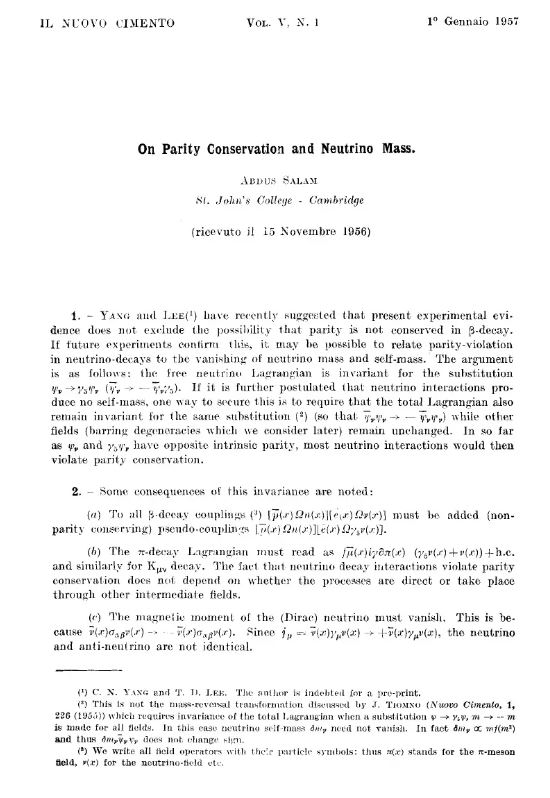
“Subsequently, Abdus Salam and John Ward worked on a local gauge theory for the weak and electromagnetic interactions, obtaining the SU(2)×U(1) model in 1964. This was a continuation of their work on the same topic that they had started in 1959. In the intervening period and thereafter, Salam had become deeply convinced that all elementary particle interactions are gauge interactions. This was a recurrent theme in his papers and lectures in the sixties. […]
“Incidentally, Sheldon Glashow in 1961 had also proposed the group SU(2)xU(1) for describing the electromagnetic and weak interactions.” (Selected Papers of Abdus Salam (With Commentary), Ed. T Kibble, C Isham, Riazuddin, A Ali, World Scientific Series in 20th Century Physics, Vol. 5, p. 149)

Even Norman Dombey, who has extensively been quoted in the video, has mentioned Dr Salam’s 1956 work, “On parity conservation and neutrino mass”, and stated that “Paul Matthews wrote to him [Dr Salam] from the United States, ‘you’ve really hit the jackpot this time’. His friend and collaborator John Ward wrote, ‘So many congratulations and fond hopes for at least one-third of a Nobel prize’. One-third because the prize would presumably be shared with Lee and Yang.” (Abdus Salam: A Reappraisal Part I — How to Win the Nobel Prize, p. 4) Gordon Fraser has also mentioned this episode. (Cosmic Anger, Oxford University Press, p. 225)
Though at that time only Lee and Yang were awarded the Nobel Prize, considering the above-mentioned quote, it is evident that Dr Salam was already being considered by the leading physicists to be deserving of a Nobel Prize. This point is very important and its significance shall become more evident later in this article.
Shedding light on the fact that Dr Salam’s work was independent of anything done by Glashow, Frank Close has stated:
“Glashow’s thesis, in 1958, was not public knowledge outside Cal Tech, and there is no doubt that Salam and Ward’s first foray into this area was completely independent of anything that Glashow had done. In December 1958 they submitted their paper titled ‘Weak and Electromagnetic Interactions’ to the Italian journal Il Nuovo Cimento, where it appeared in February 1959. They had been inspired by Schwinger, as had Glashow. However, they had set off in a different direction than he did.” (The Infinity Puzzle, p. 120)
Mentioning the contributions of Dr Salam since the late 1950s, Glashow stated during his Nobel Lecture delivered on 8 December 1979:
“Another electroweak synthesis without neutral currents was put forward by Salam and Ward in 1959,” and “in a continuation of their work in 1961, they suggested a gauge theory of strong, weak, and electromagnetic interactions based on the local symmetry group SU(2) x SU(2). This was a remarkable portent of the SU(3) x SU(2) x U(1) model which is accepted today.” (“Towards a Unified Theory—Threads in a Tapestry”, www.nobelprize.org)
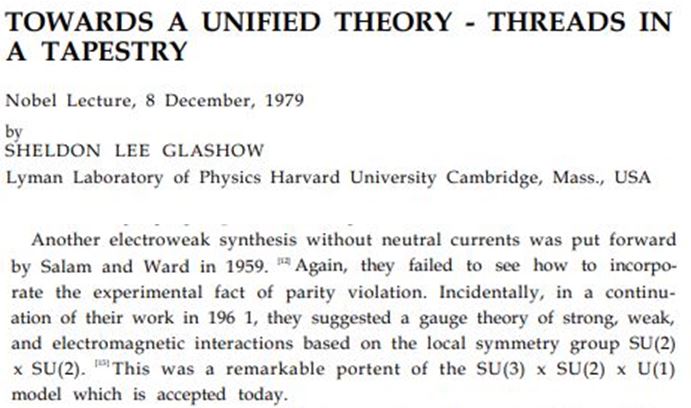
In the video, it was also claimed on the basis of The Infinity Puzzle (p. 300) that while Dr Salam published a Paper every six weeks between 1966-68, none of them was on the topic of electromagnetic and weak unification. The above-mentioned facts indicate that Dr Salam had been working on this subject, from one aspect or the other, since 1956.
Independent work
Since the video has alleged that Dr Salam’s work was not original and hence, “didn’t deserve the Nobel Prize”, it is essential to clear this misunderstanding. Even Glashow himself, in his Nobel Lecture, stated:
“We come to my own work done in Copenhagen in 1960 [published in 1961], and done independently by Salam and Ward. We finally saw that a gauge group larger than SU(2) was necessary to describe the electroweak interactions. Salam and Ward were motivated by the compelling beauty of gauge theory.” (“Towards a Unified Theory—Threads in a Tapestry”, www.nobelprize.org)
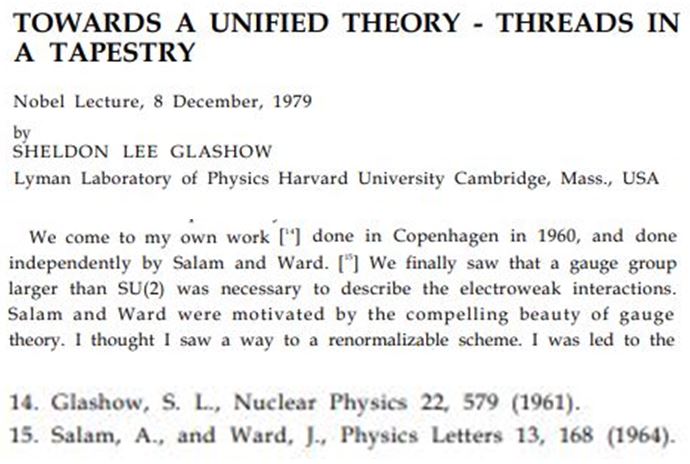
It makes it crystal clear that Dr Salam’s work in 1964 was independent and original, opposite to what has been asserted in the video.
While describing his work of 1967, Weinberg states:
“This brings me to the electroweak theory, as developed by myself, and independently by Salam. […] Afterwards, I looked back at the literature on intermediate vector boson theories from the late 1950s and early 1960s, and I found that the global SU (2) × U(1) group structure had already been proposed in 1961 by Glashow.” (50 Years of Yang-Mills Theory, Ed. Gerardus ‘t Hooft, pp. 105-107)
This means that, firstly, even Weinberg independently came to the same conclusion as Glashow and, secondly, that even he did not know about Glashow’s work up until 1967.
He then highlights a crucial point by stating that “the four of us had independently come to the same SU (2) x U (1) group structure.” (Ibid., p. 107)
Here, “four of us” means Dr Salam, Glashow, Ward and Weinberg.
In his Nobel Lecture as well, Weinberg stated that “The naturalness of the whole theory is well demonstrated by the fact that much the same theory was independently developed by Salam in 1968.” (“Conceptual Foundations of the Unified Theory of Weak and Electromagnetic Interactions”, www.nobelprize.org)
Sir Thomas Walter Bannerman Kibble, a British theoretical physicist, has narrated about “the history of the development of the unified electroweak theory” as he saw it from his “standpoint as a member of Abdus Salam’s group at Imperial College”, and stated:
“In 1964, Salam and his long-term collaborator John Ward, apparently unaware of Glashow’s work, proposed a very similar model also based on SU(2)×U(1).” (“History of electroweak symmetry breaking”, https://arxiv.org)
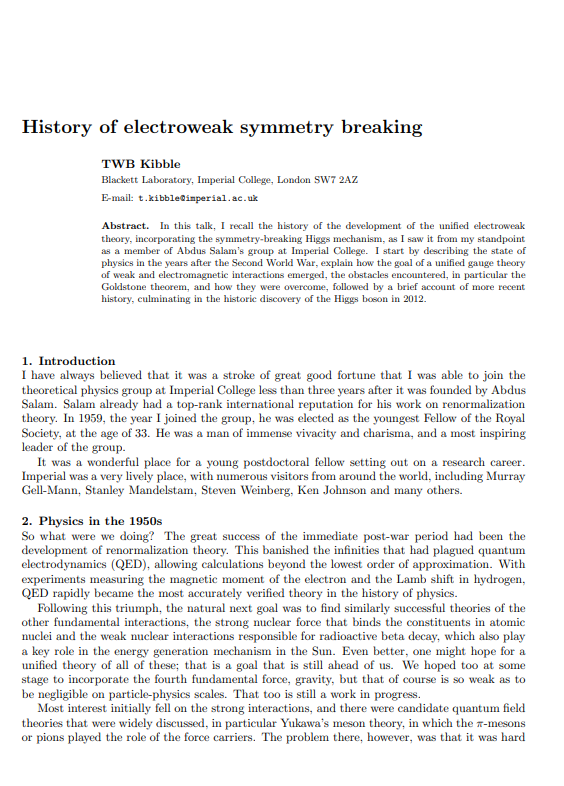
The critic is taking up so much time to talk about the 1961 Paper of Glashow and the 1964 Paper of Dr Salam and Ward, although this is not at all the basis for Dr Salam’s Nobel Prize. Glashow was awarded the Nobel Prize because of it, but not Salam. So there is no point in talking in such length about that episode.
In addition to the 1964 Paper of Dr Salam, the critic has also attempted to cast doubts on Dr Salam’s 1967 work as well. Hence, it seems important to quote Peter Woit who has mentioned the problems in Glashow’s model and the subsequent independent works by Dr Salam and Weinberg, in the following words:
“One more idea was needed to fix the gauge symmetry problems of the Glashow model and make it consistent. What was needed is something that has come to be known as a Higgs field […] Steven Weinberg came up with what was essentially Glashow’s model for a unified model of the weak and electromagnetic interactions, but augmented with a Higgs field so that the quanta carrying the weak force would be massive while maintaining the gauge symmetry of the theory. The same idea was independently found by Abdus Salam, and this kind of unified model of electro-weak interactions is now known variously as the Weinberg-Salam or Glashow-Weinberg-Salam model. […] It was this idea [Higgs mechanism] that Weinberg and Salam used in 1967 to turn Glashow’s earlier model into the one that would be the basis of the electro-weak part of the standard model.”
Woit mentions a very important point that Glashow’s “early version of the electro-weak theory was incomplete (unlike the later Weinberg-Salam model) because it lacked something like the Higgs to break the gauge symmetry.” (“Not Even Wrong: The Failure of String Theory and the Continuing Challenge to Unify the Laws of Physics”, Jonathan Cape London, pp. 78, 83, and 100)
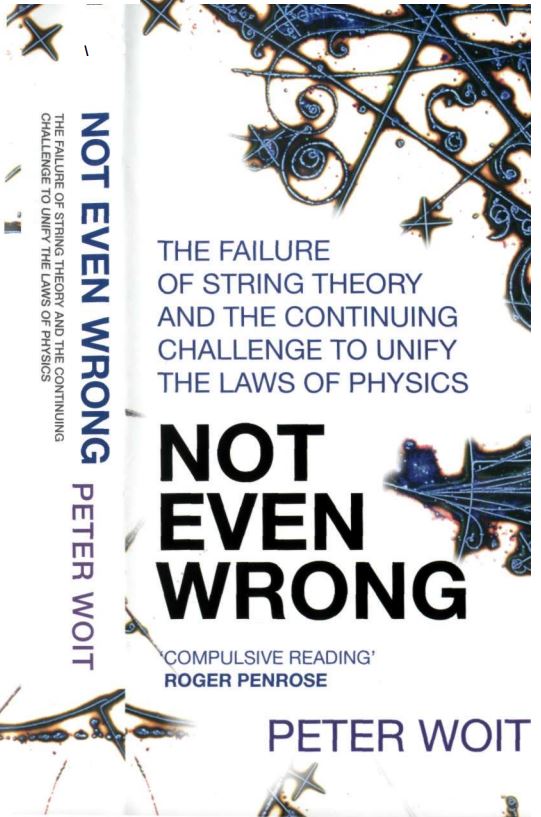
S. Gasiorowicz (American theoretical physicist) and P. Langacker (Emeritus Professor of Physics and Astronomy at the University of Pennsylvania) have also stated, “S. Weinberg (1967) and independently A. Salam (1968) proposed an extremely ingenious theory unifying the weak and electromagnetic interactions.” (“Elementary Particles in Physics”, www.physics.upenn.edu)
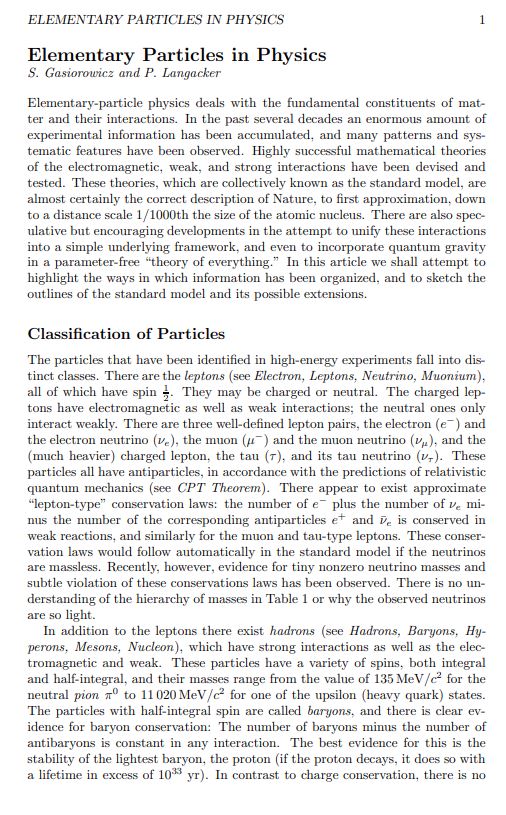
No documentary evidence?
In the video, Norman Dombey has been cited to support the notion that there is no documentary evidence of the 1967 lectures at the Imperial College. However, the fact is that Dr Salam “gave a series of lectures on the complete electroweak theory in the autumn of 1967, but did not publish until the spring of 1968 in the Proceedings of a Nobel Symposium.” (“Professor Abdus Salam (1926-1996), Nobel Prize in Physics 1979”, www.imperial.ac.uk)
Let’s see what Frank Close has to say about this. He goes into sufficient detail about these lectures to refute this allegation:
“Salam’s priority for discovering this golden path, independent of Weinberg, who published his theory in November 1967, is that he had already given some lectures at Imperial College during 1967, in which he outlined his ideas on spontaneous symmetry breaking. These lectures, which, as we shall see, probably occurred in October 1967, collectively form the germ of what became known in the 1970s as the Weinberg-Salam model. […]
“Chris Isham, who became one of Salam’s research collaborators, recalled having heard ‘some lectures on electroweak theory just after the end of my first year,’ which is consistent with the autumn of 1967. The only detailed memory comes from Bob Delbourgo, who was a research collaborator of Salam and is today emeritus professor in Tasmania.
“During Kibble’s absence, Delbourgo took responsibility for organizing the seminars. Abdus Salam liked to talk about his pet projects, and Delbourgo told me that Salam wanted to give a series of lectures about his recent work on the spontaneous breakdown of symmetry in gauge theories. Delbourgo recalls, ‘To the best of my recollection I organized some three talks on Tuesday afternoons where he explained his now famous work.’ Unfortunately, Delbourgo took no notes and knows of no one else who did: ‘It all seemed so esoteric at the time.’
“‘Soon after this,’ Delbourgo told me, he was in the physics departmental library and saw Weinberg’s article in Physical Review Letters, which Delbourgo thought ‘looked suspiciously like what Salam had recounted to us.’ He mentioned this to Salam, who ‘looked really chagrined and worried. So I urged him to write up his work as soon as possible, as it was done independently and at roughly the same time as Weinberg’s. Salam mentioned that there was to be a Nobel Symposium, and that this would provide a vehicle for rapid publication of his own work.’ […]
“There is no doubt that some lectures by Salam took place, though it is less clear whether more than a handful of people were present. Delbourgo’s testimony is confident even after four decades; he played a seminal role in the events, which are burned in his memory. The only written record that I have found is a letter, which was sent in 1976 to Ivar Waller, of the Nobel Committee for Physics.” (The Infinity Puzzle, pp. 298-299)
He further mentions that Paul Matthews wrote to Waller, “confirming that he had attended ‘the course of postgraduate lectures … during the autumn term of 1967 at which [Salam] described the unified gauge theory of weak and electromagnetic interactions using the recent work of Kibble… At the time these lectures were delivered, Weinberg’s work had not appeared.’” (Ibid., p. 301)
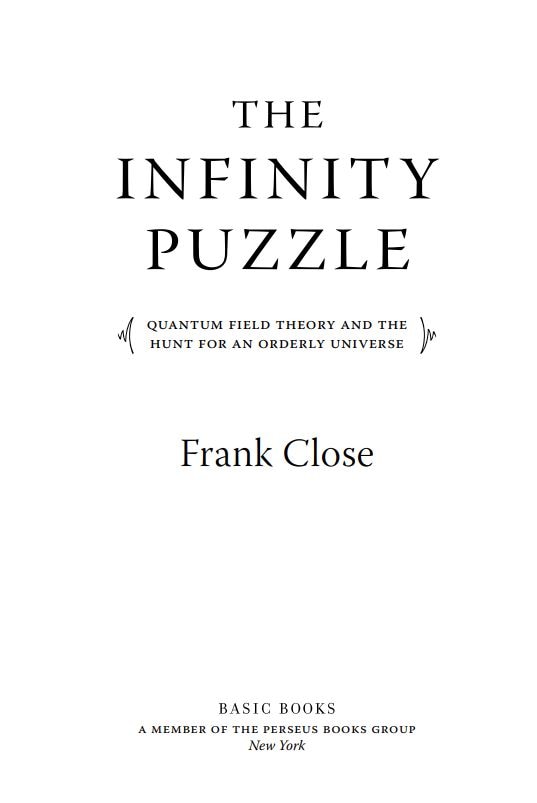
Mentioning the unified gauge theory of weak and electromagnetic interactions proposed by Weinberg and Dr Salam, Kibble states:
“Essentially, the same model was presented independently by Salam in lectures he gave at Imperial College in the autumn of 1967—he called it the electroweak theory. (I was not present because I was in the United States, but I have had accounts from others who were.) Salam did not publish his ideas until the following year, when he spoke at a Nobel Symposium, largely perhaps because his attention was concentrated on the development in its crucial early years of his International Centre for Theoretical Physics in Trieste.” (“History of electroweak symmetry breaking”, https://arxiv.org)
Though the video acknowledges the accounts of Robert Delbourgo and Paul Matthews, it attempts to undermine those testimonies. Robert Delbourgo’s detailed account is as follows:
“I have been asked by the organizers to comment upon the birth of the standard model during 1967 and Salam’s prominent role in it. This is an excellent occasion to set the record straight and recount my view of its history; if nothing else to refute innuendos which have occasionally surfaced during the 1970s that Salam was not deserving of the Nobel Prize. That autumn of 1967 I had been in charge of organizing the seminars at IC. Because Salam was constantly on the move and hardly spent more than one month at a stretch in London, I arranged with him to give a couple of lectures on his recent research (in October, to the best of my recollection) during his spell at IC to kick off the seminar season, as it was early in the academic year. He agreed to do so even though the audience attending those talks was somewhat thin. Paul Matthews was certainly present, but Tom Kibble was away in sabbatical in the USA. My memory of his lectures is a bit indistinct nowadays, but I do remember that he kept on invoking these k-meson tadpoles which disappeared into the vacuum which induced the spontaneous breaking of the gauge symmetry: what we now know as the expectation value of the Higgs boson.”
He further states:
“A week or so later, I wandered into the Physics Library and came across Steven Weinberg’s Physical Review Letter, which I noticed looked suspiciously like Salam’s attempt. I showed the article to Salam, who was rather troubled that it was almost the same as his own research, but which was of course entirely independent. Matthews and I urged him to publish his work at the earliest opportunity and this happened to be the upcoming Nobel Symposium. As they say, ‘the rest is history.’ I hope that this account of the events at the time scotches all aspersions that Salam should not have been a prize recipient.” (Memorial Volume on Abdus Salam’s 90th Birthday, Ed. Lars Brink, Michael Duff, Kok Khoo Phua, p. 13)
Even Dr Salam himself, as acknowledged in the video, made it clear at the 1968 Nobel Symposium that “The material I shall present today, incorporating some ideas of Higgs & Kibble, was given in lectures (unpublished) at Imperial College.” (“Elementary Particle Theory—Proceedings of the Eighth Nobel Symposium held May 19-25, 1968…”, p. 367)

The video quotes Norman Dombey again, where he states, “The proceedings of the Nobel Symposium [of 1968] were published as an expensive monograph with circulation limited to a few specialist libraries. Hardly any of the more than 1500 of physicists who have cited Salam 1968 in their papers have read the paper.” (Abdus Salam: A Reappraisal Part I — How to Win the Nobel Prize, p. 9)
Here, too, Dombey has made nothing more than a pure assumption, yet he is presented as a witness in the video.
As far as the significance of Dr Salam’s work in 1967 is concerned, the following passage would be enough:
“In the years 1961-64, a lively debate developed about whether the Goldstone theorem could be evaded. P.W. Anderson, using an analogy with the superconductor, pointed out that the Goldstone (plasmon) mode becomes massive due to the gauge field interactions whereas the electromagnetic modes are also massive due to the Meissner effect, despite gauge invariance. However, Anderson had not explicitly given a proof of the evasion of the Goldstone theorem in a relativistic theory. This proof was provided in subsequent theoretical developments pioneered by Peter Higgs, and independently by F. Englert and R. Brout. They also proposed a mechanism by which local symmetries could be broken spontaneously without introducing Goldstone bosons. That this was a way to give masses to the gauge bosons and fermions without introducing explicit mass terms in the Lagrangian was immediately sensed by Salam, and independently by Steven Weinberg. So, all the ingredients mentioned earlier, namely local gauge theory, γ5-symmetry (leading to chiral fermions), and renormalizability, on which Salam had worked for years, were there. In 1967/68, these developments culminated in the famous papers of Weinberg and Salam resulting in the electroweak unification (a name coined by Salam), based on the SU(2)×U(1) group with spontaneous symmetry breaking. This was a crucial step in the construction of a viable theory of weak interactions, made possible by the imaginative strokes of genius of Higgs, Salam and Weinberg.” (Selected Papers of Abdus Salam (With Commentary), Ed. T Kibble, C Isham, Riazuddin, A Ali, World Scientific Series in 20th Century Physics, Vol. 5, p. 150)
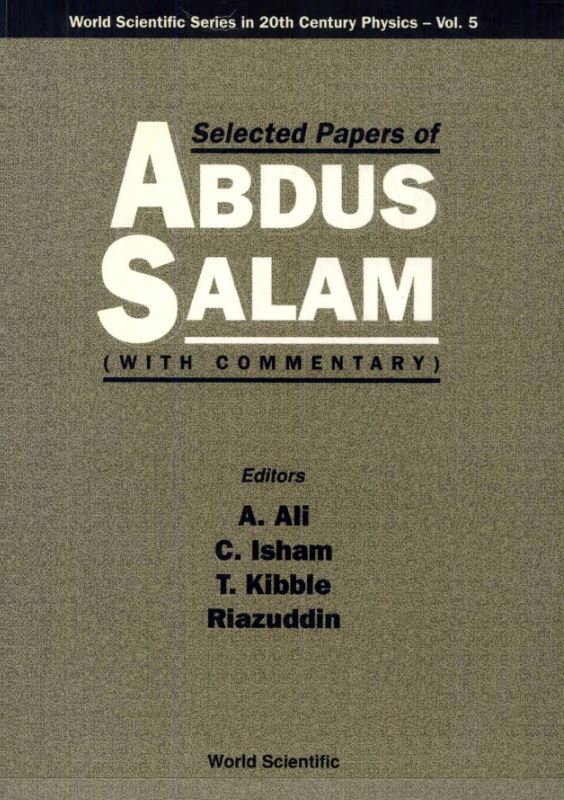
In addition to asserting that Dr Salam “copied” Glashow’s 1961 Paper, the critic gave another false impression that Dr Salam did not have any significant work in the following years too that could be deemed deserving of a Nobel Prize. Hence, it becomes essential to present some crucial points from Glashow’s Nobel Lecture of 1979, wherein he narrated the timeline of the whole story, as in what was accomplished when and by whom, and highlighted the crucial role of Dr Abdus Salam at several junctures during the post-1964 era. For instance, he stated:
“It soon became clear that a more far-reaching analogy might exist between electromagnetism and the other forces. They, too, might emerge from a gauge principle. A bit of a problem arises at this point. All gauge mesons must be massless, yet the photon is the only massless meson. How do the other gauge bosons get their masses? There was no good answer to this question until the work of Weinberg and Salam [1967-68] as proven by ‘t Hooft (for spontaneously broken gauge theories) [1971-72] and of Gross, Wilczek, and Politzer (for unbroken gauge theories) [1973]. Until this work was done, gauge meson masses had simply to be put in ad hoc.”
He further said:
“Both Salam and Weinberg had had considerable experience in formal field theory, and they had both collaborated with Goldstone on spontaneous symmetry breaking. In retrospect, it is not so surprising that it was they who first used the key. Their SU (2)XU (1) gauge symmetry was spontaneously broken. The masses of the W and Z and the nature of neutral current effects depend on a single measurable parameter, not two as in my un-renormalizable model. The strength of the neutral currents was correctly predicted. The daring Weinberg-Salam conjecture of renormalizability was proven in 1971. Neutral currents were discovered in 1973, but not until 1978 was it clear that they had just the predicted properties.” (“Towards a Unified Theory—Threads in a Tapestry”, www.nobelprize.org)
ICTP, nominations and letters
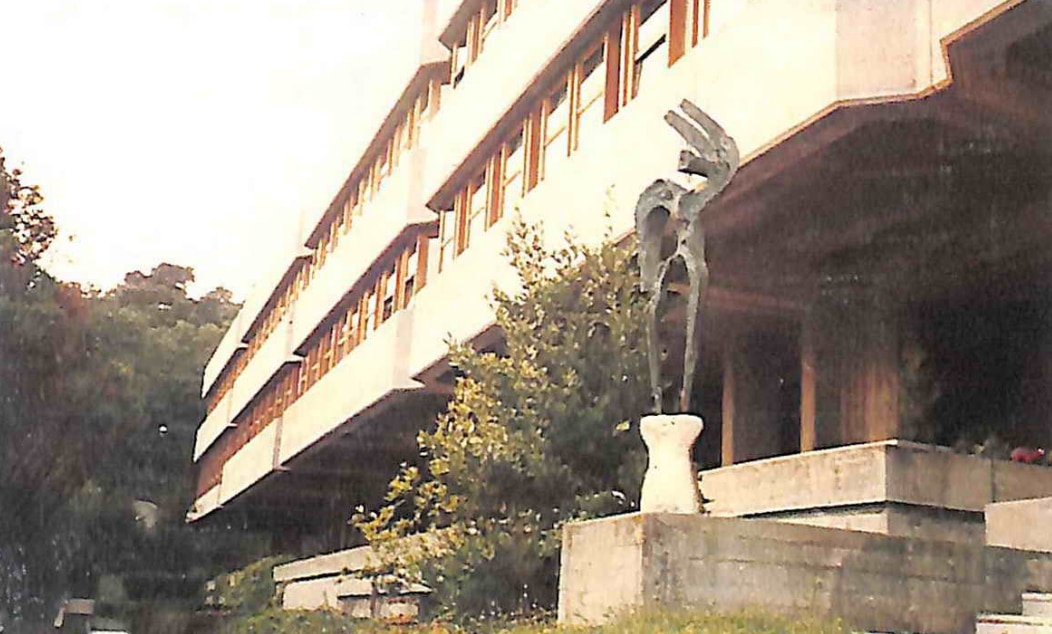
It has already been mentioned in the beginning that prominent physicists considered Dr Salam’s work deserving to be awarded the Nobel Prize even in 1957, but the video asserts that Dr Salam compelled some physicists to approach other leading physicists in order to be nominated for the Nobel Prize. As an argument, the critic states that “the Nobel Committee does not go into the depth as to how good the work is,” and “normally they trust the other physicists or people of that field” who recommend a certain individual to be awarded. He asserts that “Dr Salam was trying to somehow associate himself with the prominent individuals [of his field].”
The video claims that in the 1970s, Nobel Laureate Paul Dirac continuously nominated Dr Abdus Salam for the Nobel Prize due to Dr Salam’s involvement with the ICTP (The Abdus Salam International Centre of Theoretical Physics), which Dirac had a standing invitation to visit, with expenses paid. Strangely, the critic politicised the ICTP’s establishment, asserting it was linked to the Italy-Yugoslavia conflict over Trieste, and portrays Dr Salam as using his influence to compel nominations, citing Norman Dombey’s work as proof. However, there is no evidence that Dr Salam had any vested interest in the ICTP’s establishment.
The critic also mentions that Ivar Waller, member of the Nobel Committee from 1945-1972, would also visit the ICTP every summer. He seems to be portraying the ICTP as a means for Dr Salam to fraternise with important physics dignitaries.
Regarding the objection that Dr Salam misused the ICTP, the following account of Miguel Ángel Virasoro – himself a theoretical physicist and former director of the ICTP (1995-2002) – is worth a read, wherein a refutation has been given to those who show prejudice against Dr Salam.
He states that Dr Salam’s approach, “at every crossroad” was “to think which way would be the right one to reach the high goals he had imposed on himself,” and “his actions were always transparent, his goals always explicit and he has worked unrelentingly for the benefit of others.
“A typical discourse that exposes those prejudices in a clear articulated way but that ends with misleading, wrong conclusions is presented by N. Dombey in an article called ‘Abdus Salam: a reappraisal’. I am not judging here the author but I want to expose how his reasoning, which may convince those who prefer a rule-abiding, neutral, unengaged individual, reveal serious limitations and lead to definitely wrong misleading conclusions.
“His basic criticism is that Abdus Salam took advantage of the ICTP infrastructure to promote his candidacy to the Nobel Prize disregarding the goals of the ICTP. […]
“[I]t is a fact, well accounted in all records of the Centre and in particular by A-M Hamende’s contribution included in the same document cited by Dombey that Salam’s Nobel prize had the following effects:
“‘The Nobel Prize to Abdus Salam is definitely the milestone in the history of the ICTP. … For the Centre, it meant a first leap in the financing of its programmes. … From 1970 to 1979, the increase in financial resources came mainly from the IAEA and UNESCO and allowed for an increase of activities (expressed in person × month) of about 3.5% every year. After the Nobel Prize until 1984, the average annual growth rate jumped to 9% thanks to increased contributions of the IAEA and the Italian Government. In 1987, the Italian Government became by far the biggest sponsor of the ICTP.’
“Furthermore Salam didn’t sit idly on the Nobel Prize. On the contrary he took it as a new opportunity to address the governments of Third World Countries to argue about importance of science for development. He took the road and visited: in 1979 Mexico; in 1980 Brazil, Peru, Colombia, Argentina and Venezuela; in 1981 India, Abu Dhabi, Kuwait, Qatar, Bahrain, Oman, and Jordan; in 1984 Kenya, Tanzania, Uganda, Zambia, Ethiopia, Malawi and Zaire; in 1986 Pakistan, Bangladesh, India, Malaysia, Singapore, Sri Lanka and Vietnam, in 1987 Senegal, Niger, Mali.” (Memorial Volume on Abdus Salam’s 90th Birthday, Ed. Lars Brink, Michael Duff, Kok Khoo Phua pp. 128-130)

The point that must be kept in mind is that the “hours spent in administrative work obviously took away from research. Steven Weinberg, who shared the Nobel Prize with Salam, remarked at the amount of time he devoted to the ICTP ‘at the cost of physics.’ ‘I don’t know that I would be able to do that,’ Weinberg said, but for Salam the matter went beyond choice.” (Ibid., p. 517)
As far as the letters are concerned, Dr Salam’s biographer, Gordon Fraser has stated, “On several occasions, Paul Dirac, as a Nobel laureate, had put Salam’s name forward to Stockholm. So had Bethe. Momentum built up after the key discovery of the neutral current in 1973. Salam’s colleague Paul Matthews wrote to Stockholm to explain how Salam had lectured on the unification idea at Imperial College in 1967, prior to its publication in the obscure proceedings of the Nobel Symposium.” (Cosmic Anger, Oxford University Press, pp. 225-226)
Kibble was among those who nominated Dr Salam for the Nobel Prize. Mentioning about what he had argued in that nomination, Frank Close stated:
“One of those who nominated Salam for the 1979 prize was Tom Kibble. In eight pages his nomination provides an elegant summary of the state of physics, recalling Salam’s breadth of contributions and identifying various aspects of Salam’s work on the weak interaction—spontaneous symmetry breaking, electroweak unity, gauge invariance—where although several had contributed, only Salam ‘played a leading role in every stage in this success story.’” (The Infinity Puzzle, p. 308)
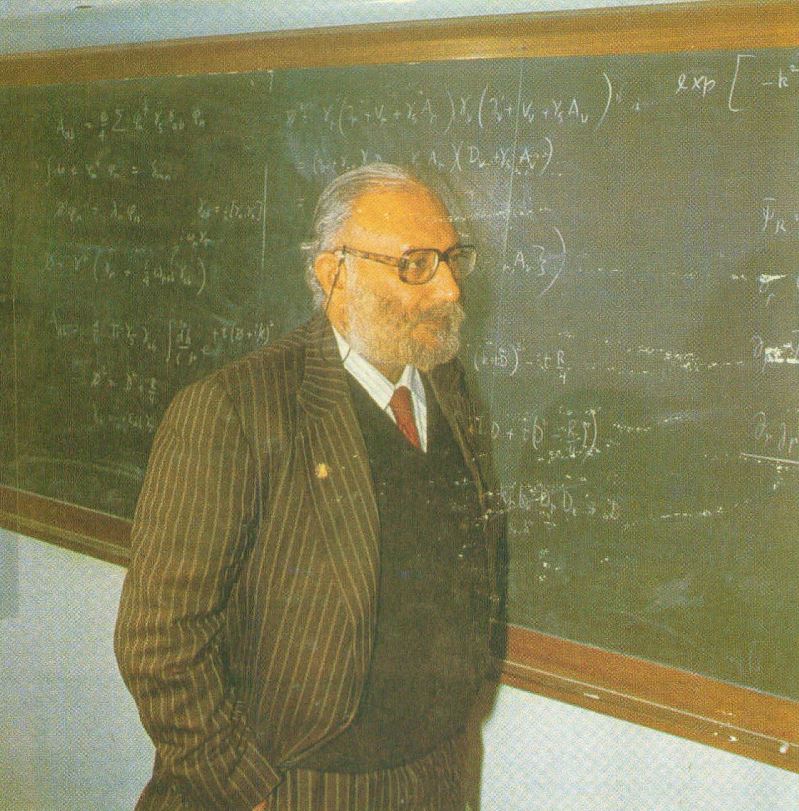
Paul Dirac would receive invitation letters from the Nobel Committee to nominate the potential physicist for the award, for instance, Dirac received letters from the Committee, asking him to make nominations for the 1972, 1974, 1975 and 1978 award. Hence, we find his handwritten letter of 1975, to the Nobel Committee—sent in 1978 as well—wherein he highlighted the 1956-57 works of Dr Abdus Salam. Mentioning Dr Salam’s contribution to the development of the particle physics, he stated:
“Most of the people who have made outstanding contributions to this development have already received the Nobel Prize, but an important exception is A Salam, who put into order our ideas about neutrinos and weak interactions.
“Salam was the first to realize the necessity for a two-component wave function for the neutrino and the principle for γ5 symmetry in neutrino interactions. He came to these ideas from theoretical arguments and they were subsequently confirmed by experiment. Other physicists, namely Landau and Yang and Lee, (all Nobel laureates) came to the same conclusion independently, but some months later than Salam.
“Because of the general obscurity of our knowledge of elementary particles people are continually bringing new ideas, which usually survive only a few years. But Salam’s ideas have stood the test of time and are now incorporated into the accepted basis of Physics.
“Salam’s work was pioneering and surprising (he had to push against strong opposition of Pauli). It was decisive in setting the character of this kind of interaction and had a big influence on the development of an important branch of physics. I feel strongly that it should be awarded with a Nobel Prize.” (The Florida State University Digital Library, https://diginole.lib.fsu.edu)
These are the words of that person who is, according to Frank Close, “one of the greatest theoretical physicists of the [20th] century.” (The Infinity Puzzle, p. 20)
Dr Salam’s 1957 paper “was cited in nominations that he be awarded a Nobel Prize — on the grounds that his theory had preceded the definitive experiments proving parity violation, and that Lee and Yang ‘had not proposed a theory of parity violation, nor attempted to link it to any deep principle of physics.’” (Ibid., p. 296)
The video then quotes Dombey, where he states, “Spurred by Ward’s and Matthews’ letters, Salam now could turn his attention to his prime goal. On the wall of his office in Trieste he put the Persian prayer ‘O Lord, work a miracle!’ And he set to work hard to make it happen using ICTP’s resources: the miracle he wished for was the Nobel Prize in Physics.” (Abdus Salam: A Reappraisal Part I — How to Win the Nobel Prize, p. 7)
Whether or not this miracle meant the Nobel Prize, there is no wrong in praying for achieving a distinction or even a well-deserving award.
The fact is that Dr Salam had accomplished many milestones that were deserving of a Nobel, as Frank Close notes that Murray Gell-Mann, Physics Nobel laureate in 1969, “judged Salam and Ward together to have made many very important contributions to particle physics, worthy of consideration for a Nobel Prize.” Gell-Mann “added that if he had been awarding a prize to Salam, he would have done so for a set of things, which included the weak interaction rather than just for that alone.” Close says, “Gell-Mann’s assessment mirrored Kibble’s nomination of Salam: A prize for Salam could be awarded for a set of things.” (The Infinity Puzzle, p. 310)
Furthermore, Close writes that “following an article by Weinberg in Scientific American in 1974”, “[i]n a letter to that journal, Ward objected to Weinberg’s having described Salam’s 1968 talk as occurring ‘later’ than Weinberg’s own contribution. In Ward’s perspective, Salam’s 1968 talk was reporting on work done with him, which had occurred ‘several years earlier’ in 1964.’” (Ibid.)
The Nobel Prize
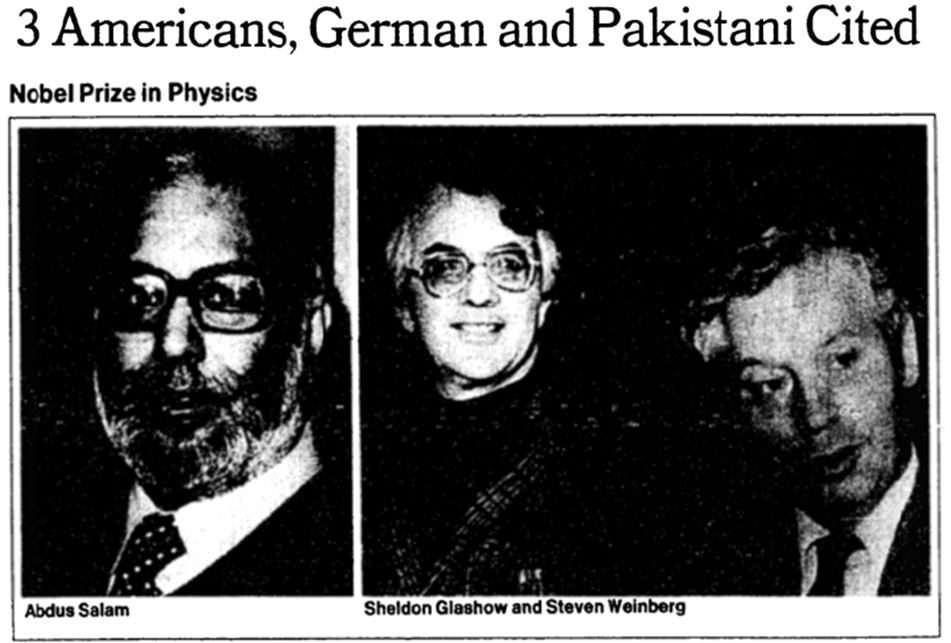
Coming to the Nobel Prize, the official press release from the institution, dated 15 October 1979, announced that Dr Salam, Glashow and Weinberg were being awarded the 1979 Nobel Prize “for their contributions to the theory of the unified weak and electromagnetic interaction between elementary particles, including inter alia the prediction of the weak neutral current.”
It further states:
“In a series of separate works in the 1960s this year’s Nobel Prize winners, Glashow, Salam and Weinberg, developed a theory which is applicable also at higher energies, and which at the same time unifies the weak and electromagnetic interactions in a common formalism. Glashow, Salam and Weinberg started from earlier contributions by other scientists.” (www.nobelprize.org)
On the official website of this institution, we find the following words that acknowledge Dr Salam’s contribution to Physics:
“According to modern physics, four fundamental forces exist in nature. Electromagnetic interaction is one of these. The weak interaction—responsible, for example, for the beta decay of nuclei—is another. Thanks to contributions made by Abdus Salam, Sheldon Glashow, and Steven Weinberg in 1968, these two interactions were unified to one single, called electroweak. The theory predicted, for example, that weak interaction manifests itself in ‘neutral weak currents’ when certain elementary particles interact. This was later confirmed.” (“Abdus Salam—Facts”, Ibid.)
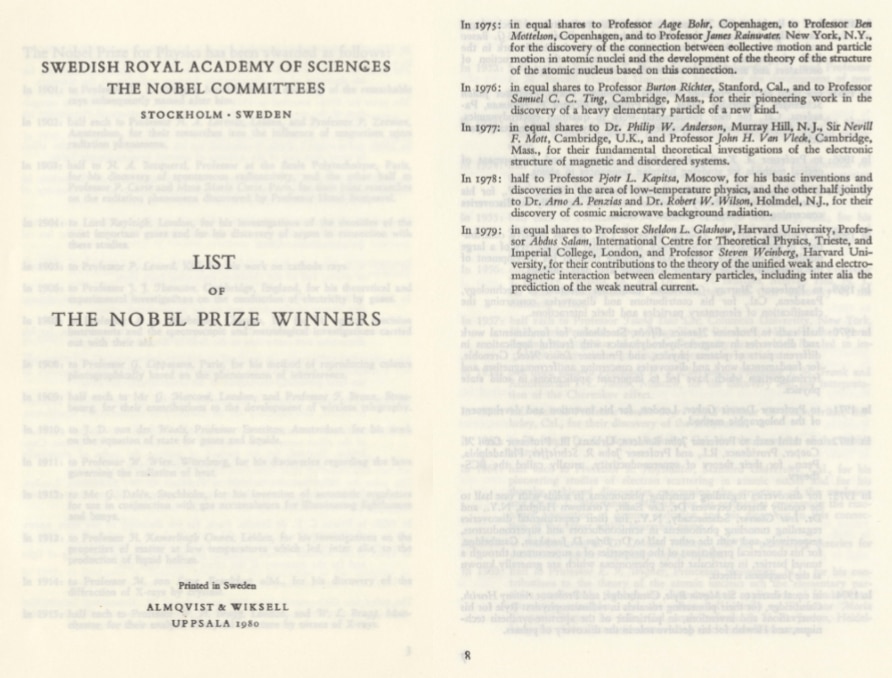
The same AIP (American Institute of Physics) from which the interview of Glashow has been cited, states:
“Abdus Salam won the Nobel Prize, along with Steven Weinberg and Sheldon Glashow, for electroweak theory. […] Salam realized that at high temperatures, the electromagnetic and weak nuclear force were the same. He showed that the two forces were components of one unified force, the electroweak force.” (“The Heritage of All Mankind—Abdus Salam and the Four Fundamental Forces”, www.aip.org)
Highlighting another important point, the same platform states:
“Abdus Salam donated all of his prize money to fund scholarships for physicists in countries underrepresented in the international physics community.” (“Biography of Abdus Salam—The Heritage of All Mankind”, Ibid.)
The critic has asserted that Dr Salam misused his influence at the ICTP to get the Nobel Prize, however, the above testimony highlights the fact that once he won the award, he donated his prize money for the further development of physics in Third World countries.
Another article on this platform states that “the story of Dr Abdus Salam is one of the most complex stories in the history of physics. Nevertheless, several things are quite clear in his life: he was deeply committed to his Ahmadi Muslim faith, he was dedicated to advancing physics in countries underrepresented in the global physics community, and his contributions to physics were groundbreaking.” (“Breaking the Barrier: Dr Abdus Salam”, Maria Stoke, Ibid.)
One ought to understand that it was not only one distinct Paper contribution that was given the Nobel Prize, but rather, it was awarded for the contributions of all three scientists over the past two decades.
Conclusion
In short, Dr Salam’s works were original and independent. He played a crucial role in the development of particle physics and there can be no doubt that he indeed deserved the Nobel Prize. Moreover, it is evident that scientific theories and ideas evolve with time and include the efforts of many, and this is what must be considered before crafting any conspiracy theories.
As far as the importance of his works in the field of particle physics is concerned, the following words from Abigail Beall – a freelance science journalist who has a master’s degree in Science Journalism – would be enough to summarise:
“In 1979, Pakistani scientist Abdus Salam won the Nobel Prize for physics. His life’s work was key to defining a theory of particle physics still used today, and it laid the groundwork for the 2012 discovery of the Higgs boson – the particle responsible for giving all other particles mass.” (“Abdus Salam: The Muslim science genius forgotten by history”, 15 October 2019, www.bbc.com)

